
Date: January 24, 2000
NASA's Hubble Space Telescope is back in business, as made dramatically evident in stunning new celestial pictures of remote galaxies and a colorful dying star released today.
The images were taken January 10 - 13, 2000, as part of the activities to recommission the earth-orbiting telescope.
The pictures are a culmination of the successful Space Shuttle servicing mission (STS-103) last December, which restored NASA's premier optical space observatory to full capability beefed-up with new electronics and critically needed replacement gyroscopes. Hubble has now resumed probing the Universe's many mysteries with a crystal-clear view.
"Thanks to the great work by the astronauts, Hubble is better than new," said Dr. Ed Weiler, NASA Associate Administrator for Space Science. "I think there is no better proof than these pictures that NASA's capability to send humans into space to work on Hubble has had a vital role in space science and the renaissance in astronomy we're now seeing."
"After a two-month hiatus, it is a tremendous boost to all of astronomy to see Hubble back in action. NASA has restored the observatory to a condition that was better than it was even before the fourth gyroscope failed," said Steven Beckwith, director of the Space Telescope Science Institute, the Hubble science operations center in Baltimore, MD.
To verify the telescope's refurbishment, astronomers resumed operations by aiming it at two scientifically intriguing and photogenic celestial targets. One object is an intricate structure of shells and streamers of gas around a dying sun-like star 5,000 light-years away.
Designated NGC 2392, it is dubbed the "Eskimo Nebula" because, as seen through ground-based telescopes, it resembles a face inside a furry parka. In Hubble's sharp view, the "furry" features resemble giant comets all pointing away from the central star, like the spokes of a wheel. "The clumps that form the comet heads all seem to be located at a similar distance from the star. This fact will be important in developing a theory of why the clumps formed in the first place," said planetary nebula expert J. Patrick Harrington of the University of Maryland, College Park, MD. He adds, "Of all the planetary nebulae imaged by the Hubble Space Telescope, this new image is unsurpassed in subtle beauty."
A second target is a massive cluster of galaxies called Abell 2218, which acts like a giant zoom lens in space. The gravitational field of the cluster magnifies the light of more distant galaxies far behind it, providing a deep probe of the very distant universe. The cluster was imaged in full color, providing astronomers with a spectacular and unique new view of the early universe.
"For the first time we can view the internal color structure of some very distant galaxies. This gives us new insight into details of what young galaxies are like," says Richard Ellis at the California Institute of Technology, Pasadena, and University of Cambridge, England and a co-investigator on an earlier (black- and-white) Hubble image of Abell 2218 taken in 1994. "The color of a distant source is preserved by gravitational lensing. By matching images of the same color, families of multiple images produced by the lensing process can be identified."
Andrew Fruchter, leader of the team who took the early release observations is particularly fascinated by an unusual red feature in the field. "This extraordinary object has colors which indicate it is one of two things, either a rare, extremely cool dwarf star in our own galaxy, or one of the most distant objects ever viewed by Hubble lensed into visibility by the mass of the cluster," says Fruchter. Further observations will be needed to confirm the identity of this unusual object.
Spacecraft operators report that all the new equipment installed on the telescope in December is working perfectly, including the new computer, solid state recorder, and fine guidance sensor. In particular the new gyroscopes are allowing Hubble to reliably point with exquisite precision at celestial objects.
Two key science instruments, the Wide Field and Planetary Camera 2 and the Space Telescope Imaging Spectrograph, are now being used for routine science observations by astronomers worldwide to probe everything from planets, to black holes, to far flung galaxies.
How did the Eskimo Nebula get its name, and what are the most interesting details in the picture?
This stellar relic, first spied by William Herschel in 1787, is nicknamed the "Eskimo" Nebula (NGC 2392) because, when viewed through ground-based telescopes, it resembles a face surrounded by a fur parka. In this Hubble telescope image, the "parka" is really a disk of material embellished with a ring of comet-shaped objects, with their tails streaming away from the central, dying star. The Eskimo's "face" also contains some fascinating details. Although this bright central region resembles a ball of twine, it is, in reality, a bubble of material being blown into space by the central star's intense "wind" of high-speed material.
What does the picture of Abell 2218 reveal to astronomers?
This "hefty" cluster resides in the constellation Draco, some 2 billion light-years from Earth. The cluster is so massive that its enormous gravitational field deflects light rays passing through it, much as an optical lens bends light to form an image. This phenomenon, called gravitational lensing, magnifies, brightens, and distorts images from faraway objects. The cluster's magnifying powers provide a powerful "zoom lens" for viewing distant galaxies that could not normally be observed with the largest telescopes.
This useful phenomenon has produced the arc-shaped patterns found throughout the Hubble picture. These "arcs" are the distorted images of very distant galaxies, which lie 5 to 10 times farther than the lensing cluster. This distant population existed when the universe was just a quarter of its present age. Through gravitational lensing these remote objects are magnified, enabling scientists to study them in more detail. This analysis provides a direct glimpse of how star-forming regions are distributed in remote galaxies and yields other clues to the early evolution of galaxies.
No comments:
Post a Comment